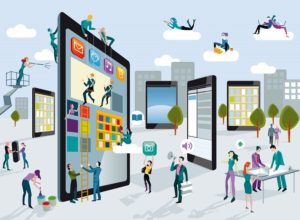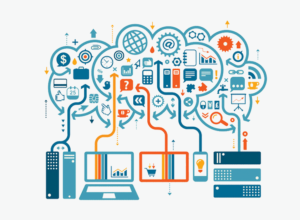Tag: digitalization
5 disruptive tech trends to watch in 2017
We are living in increasingly digital world, but there are several emerging technologies, that will probably be a catalyst for long-term innovation. In 2016 tech like AI, VR, AR, Chatbots and automated cars took major leaps in terms of their adoption and we can certainly say that robots are no longer coming, because they are already here.
In the age of digital transformation disruption has become the key word for innovative businesses. And now almost every industry from transport to finance is facing big changes through technology.
This year we can expect more connectivity, more automation and more significant impact of technology in investment and business than ever before. Here are the 5 most important technological trends that everyone must watch for:
Artificial Intelligence (AI)
Artificial intelligence is already a part of journalism, healthcare and even customer support with the rise of chat bots. Many expert believe that 2017 will be the year we embrace the cultural shift and start trusting AI with more and more jobs, that were previously done manually.
Facebook CEO Mark Zuckerberg showed us the best of smart homes innovation with his house virtual assistant, but there is still a lot to come. Gartner defined AI and machine learning as the two most disruptive trends of the year.
Virtual Reality (VR)
This year virtual reality is finally breaking the limits of digital entertainment and gaming sectors and is going out in the mainstream. The two spheres, that are most likely to benefit from the invasion of VR are Education and Healthcare. But soon the next reality will be found in nearly every aspect of our lives.
Now it’s up to the business to find out how virtual reality can add value to its marketing, customization of products and much better customer experience.
Immersive experiences with AR and VR are reaching tipping points in terms of price and capability but will not replace other interface models.
3D Printing
Although 3D printing can hardly be defined as a new technology, the real advances in this field came during the last 5 years. 3D printing is going to disrupt manufacturing, e-commerce and retail, not only with new method for mass production, but with ways for personalization.
Meanwhile, the idea for Tesla’s smart factories, in which machines are building machines, are just a step towards the concept of self-replication robotics, drones and home systems.
Digital Identification & Biometrics
With the coming age of IoE we are quickly moving to a time, where our personal information will all be stored biometrically. This process has already started with fingerprint sensors on our phones, but soon the biometric identification will spread to face recognition and iris scans.
This year will mark the beginning of ”digital twin” representation. This innovation will allow analysis and simulation of real world conditions and improving of operations using data on how the components of a device operate end respond to environment.
Automated vehicles
The era of automated vehicles is just around the corner. It will affect not only the sector of transportation, but also the labour market, city traffic and air quality and even the way we spend our free time.
The driverless cars will offer numerous social benefits, such as better personal mobility, decline in the number of injuries and fatalities and increased productivity, due to the time freed up while traveling.
Although we can’t expect a fully autonomous car this year, we will see more and more companies present their concepts about their future models, where the driving is not the focal point of the user experience.
In the next few years we will see self-driving taxi services, provided by companies like NuTonomy, Uber and Lyft, while automation giants, such as Ford, BMW and Toyota will continue their work on providing the best product for this new market niche.
You can learn more about the newest trends in technology sector by attending to Webit.Festival Europe. During the two-day agenda of the festival in Sofia you can listen to top level speakers from all over the world, who will share their experience on topics, such as Marketing & Innovation, FinTech & Blockchain, Big Data & Cloud, IoE, Digital Transformation, Security & Privacy, Health & Wellbeing and Mobility.
Bernd Heinrichs: Digitalization is global, it neglects borders
Continuing innovations, connecting devices, machines. Connected people, cars, homes, transport - everything surrounding us is an open system, where you can just plug yourself in anytime you want.
All parking lots have cameras which watch for empty spaces and feed the data to mobile application. This is saving everyone half an hour every day. Pollution has also declined by 30%. Waste management companies only come when the bins are full, as they get real time information.
"Digitalization is global, it neglects borders. It generates opportunities, but it can also create some risks. Even though CISCO has 50bn in cash they might disappear from the market completely in just 5 years if they don’t make the right decisions and restructure. Innovation has to be driven everywhere, not just in the Silicon Valley, said Bernd Heinrichs, Managing Director IoT EMEAR Cisco in his speech at CEE Digital Summit by Webit".But first what is the Internet of Things and what is so important about it? The Internet of Things is a system, where everything is connected and everything is constantly feeding data to the cloud – starting from your smartphone and going everywhere else, like toys, microwaves, cars etc. The things themselves are not important, the data they produce is. And with that comes the question that we still haven’t answer – who owns the data? Is it the owner of the machine, is it the manufacturer, or the retailer? We have to make sure that the data doesn’t get in the wrong hands, that it is handled properly and is well secured. With the size of the network constantly growing, security will become a bigger and bigger issue. We currently have around 15bn connected things and this is just 1% of all the things we can connect. When talking about the Internet of Things we certainly can’t have a full discussion without mentioning some of the biggest problems we are facing. Challenges like limited bandwidth, latency and network unreliability have to be solved efficiently before we can move on to implementing the Internet of Things everywhere, in every industry.

